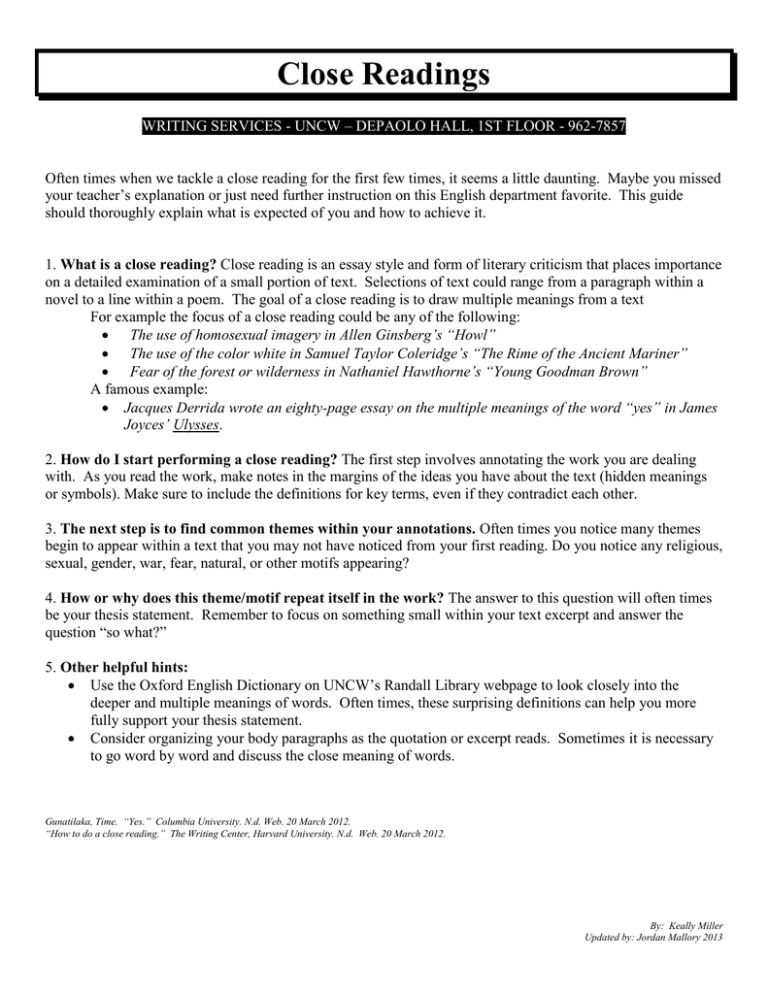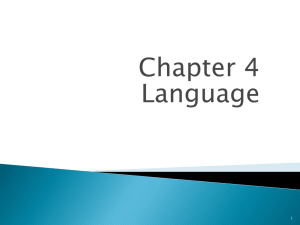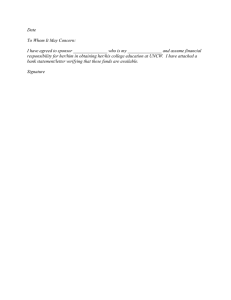Close Readings
advertisement

Close Readings WRITING SERVICES - UNCW – DEPAOLO HALL, 1ST FLOOR - 962-7857 Often times when we tackle a close reading for the first few times, it seems a little daunting. Maybe you missed your teacher’s explanation or just need further instruction on this English department favorite. This guide should thoroughly explain what is expected of you and how to achieve it. 1. What is a close reading? Close reading is an essay style and form of literary criticism that places importance on a detailed examination of a small portion of text. Selections of text could range from a paragraph within a novel to a line within a poem. The goal of a close reading is to draw multiple meanings from a text For example the focus of a close reading could be any of the following: The use of homosexual imagery in Allen Ginsberg’s “Howl” The use of the color white in Samuel Taylor Coleridge’s “The Rime of the Ancient Mariner” Fear of the forest or wilderness in Nathaniel Hawthorne’s “Young Goodman Brown” A famous example: Jacques Derrida wrote an eighty-page essay on the multiple meanings of the word “yes” in James Joyces’ Ulysses. 2. How do I start performing a close reading? The first step involves annotating the work you are dealing with. As you read the work, make notes in the margins of the ideas you have about the text (hidden meanings or symbols). Make sure to include the definitions for key terms, even if they contradict each other. 3. The next step is to find common themes within your annotations. Often times you notice many themes begin to appear within a text that you may not have noticed from your first reading. Do you notice any religious, sexual, gender, war, fear, natural, or other motifs appearing? 4. How or why does this theme/motif repeat itself in the work? The answer to this question will often times be your thesis statement. Remember to focus on something small within your text excerpt and answer the question “so what?” 5. Other helpful hints: Use the Oxford English Dictionary on UNCW’s Randall Library webpage to look closely into the deeper and multiple meanings of words. Often times, these surprising definitions can help you more fully support your thesis statement. Consider organizing your body paragraphs as the quotation or excerpt reads. Sometimes it is necessary to go word by word and discuss the close meaning of words. Gunatilaka, Time. “Yes.” Columbia University. N.d. Web. 20 March 2012. “How to do a close reading.” The Writing Center, Harvard University. N.d. Web. 20 March 2012. By: Keally Miller Updated by: Jordan Mallory 2013

![Word Study [1 class hour]](http://s3.studylib.net/store/data/007905774_2-53b71d303720cf6608aea934a43e9f05-300x300.png)




